The Toshiba Q300 SSD Review: Toshiba Becomes a Retail Brand
by Billy Tallis on February 26, 2016 8:00 AM ESTSequential Read Performance
The sequential read test requests 128kB blocks and tests queue depths ranging from 1 to 32. The queue depth is doubled every three minutes, for a total test duration of 18 minutes. The test spans the entire drive, and the drive is filled before the test begins. The primary score we report is an average of performances at queue depths 1, 2 and 4, as client usage typically consists mostly of low queue depth operations.
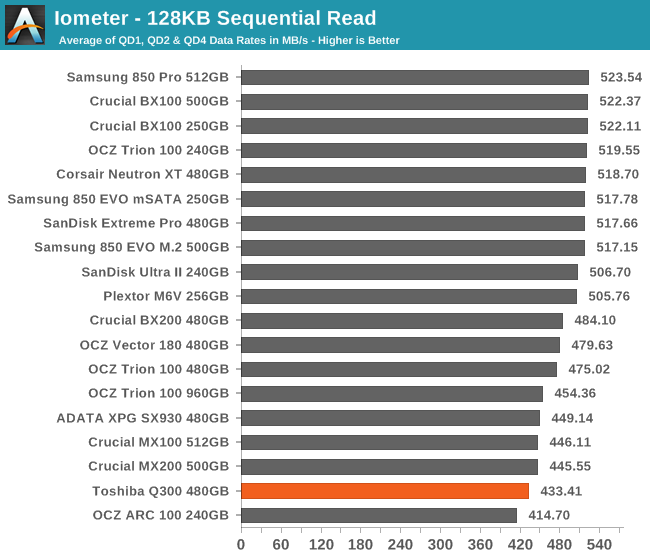
The Q300 shows a 9% performance drop relative to the 480GB Trion 100 on the sequential read test. It manages to stay out of last place, but it still disappoints and is clearly not bumping against the limits of the SATA interface at low queue depths.
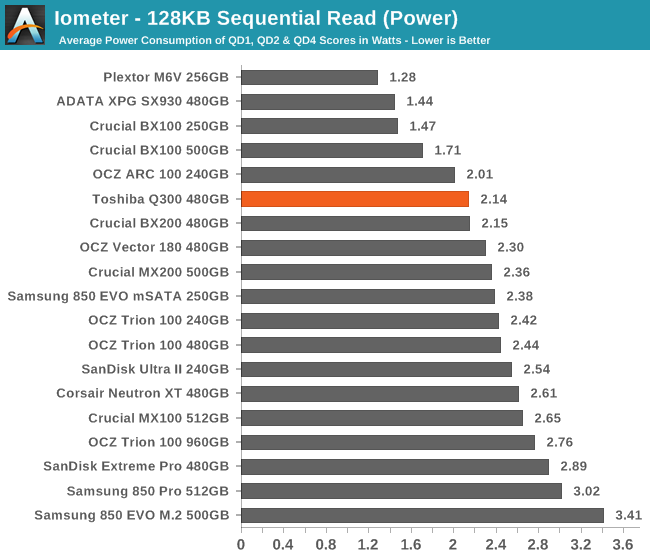
There's considerably more spread in power draw than performance on the sequential read test. The Q300's power consumption is good but not great, and most of the top performers sacrifice efficiency relative to the Q300.
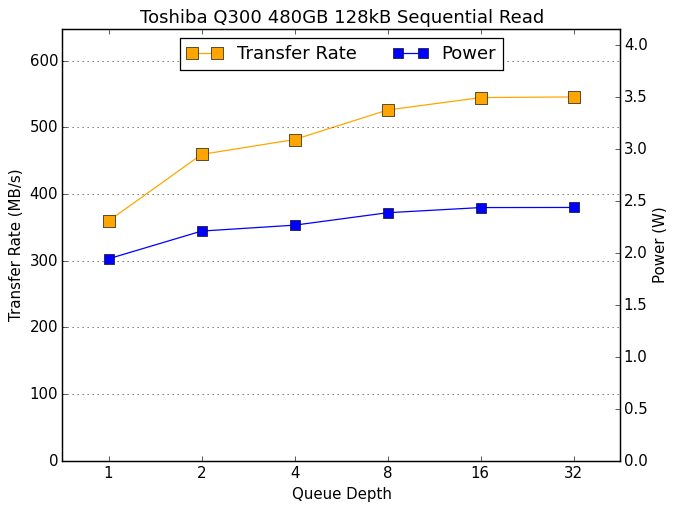 |
|||||||||
Like the larger capacities of the Trion 100, the Q300 doesn't reach full performance until QD16, and even then it's still about 10MB/s slower than the Trion 100 and closer to 20MB/s slower than the fastest SATA drives.
Sequential Write Performance
The sequential write test writes 128kB blocks and tests queue depths ranging from 1 to 32. The queue depth is doubled every three minutes, for a total test duration of 18 minutes. The test spans the entire drive, and the drive is filled before the test begins. The primary score we report is an average of performances at queue depths 1, 2 and 4, as client usage typically consists mostly of low queue depth operations.
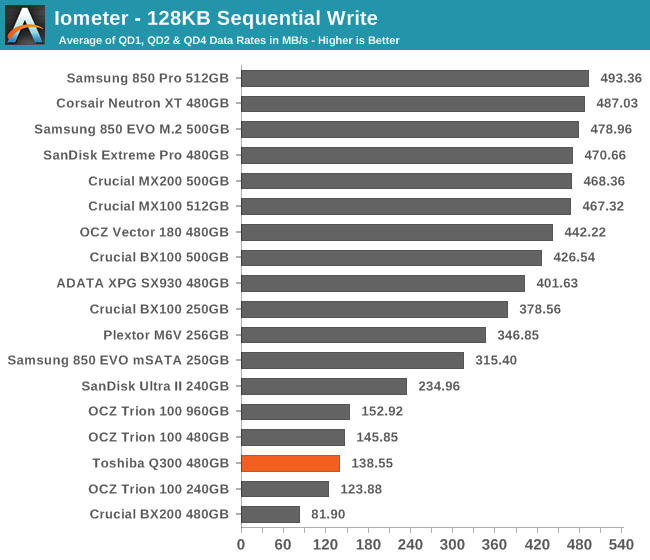
Like the Trion 100, the Q300 does not perform well for sequential writes. The SanDisk Ultra II uses very similar flash, but its Marvell controller and different implementation of pseudo-SLC write caching manages much higher throughput.
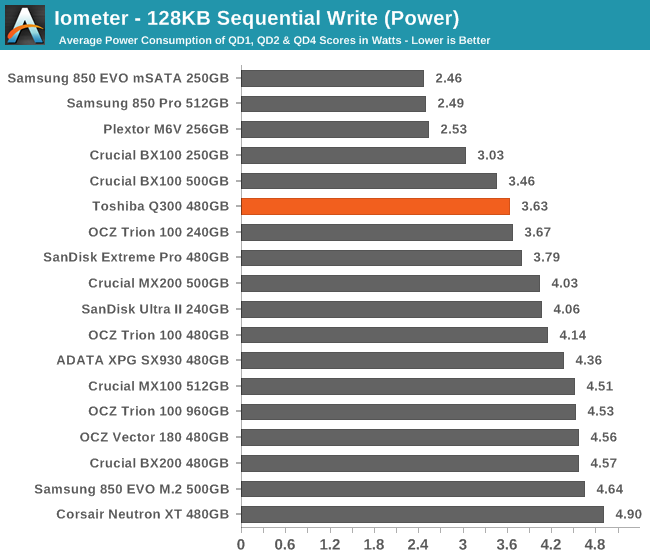
The Q300 is slightly more efficient than the Trion 100, but the planar TLC drives simply cannot hide the power cost of their longer flash program procedure.
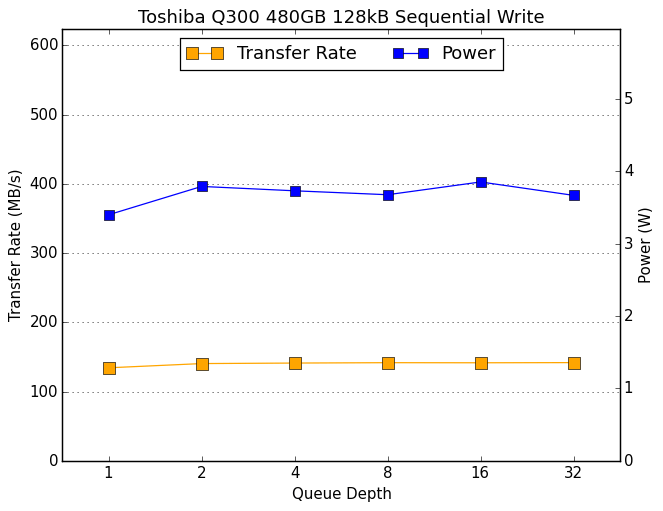 |
|||||||||
The Q300's sequential write performance is almost entirely unaffected by queue depth, and its power consumption varies only slightly. The top performers typically hit their limit once queue depth increases to two. When used with MLC flash in the Corsair Neutron XT, the Phison controller architecture was able to offer top-notch write speed that scaled with queue depth, but that was lost in adapting the firmware for use with TLC flash.










30 Comments
View All Comments
cbjwthwm - Monday, March 7, 2016 - link
Yes that quote in the review is out to lunch, this drive had the same problems as the Trion 100 with launching on flawed firmware 11.1, which had major reliability bugs--hence the bad user reviews like the Trion 100. Toshiba's link to the updated 11.2 firmware (from late November) is here:http://support.toshiba.com/support/viewContentDeta...
The reviewer needs to at least search for an updated firmware version before writing such oblivious comments that make his review seem very badly researched right off the mark.
serendip - Friday, February 26, 2016 - link
Big issue with the Q300 and its identical twin OCZ Trion 100 - they don't work with certain Nvidia chipsets, mainly those in Macbooks from 2010 and earlier. You can format the drive on a Macbook but read/write operations stall.OCZ are aware of the problem but have stated on their official forum that they can't do anything to avoid breaking support for newer chipsets. Toshiba haven't said a darn thing.
yuhong - Saturday, February 27, 2016 - link
Is there any more technical details like which part of the SATA protocol the problems comes from?serendip - Saturday, February 27, 2016 - link
No idea, maybe some power management issues? I've tried Sandforce and Samsung 850 Evo drives on those older Macbooks and they work fine. It's the new Toshiba controller that doesn't play well with MCP79/89 chipsets. OCZ have known about this for 3 months and have told customers facing this situation to get a refund and buy another drive whereas Toshiba are keeping silent. Guess that OCZ acquisition hasn't streamlined corporate lines of communication.Kristian Vättö - Sunday, February 28, 2016 - link
From what I've heard it's a problem Apple would have to fix through a firmware update. OCZ/Toshiba can't fix it, or at least not without massive changes. In the end it's a relatively small niche anyway.serendip - Saturday, February 27, 2016 - link
It happens only under OSX, all versions, on the Nvidia MCP chipset platform. The Q300 works fine in Windows on those affected Macbooks.cbjwthwm - Monday, March 7, 2016 - link
The nVidia SATA compatibility problem lies with the drive's Phison S10 controller, and it affects all products using that controller from various manufacturers such as Patriot, Corsair, and Kingston lines using it. Since Phison has been sitting on their hands with this issue for around a year a half (its first use was the Neutron XT iirc), I doubt they're going to get their act together for OCZ but I suppose we can hope?Harry Lloyd - Saturday, February 27, 2016 - link
Still waiting for a decent 500 GB drive under 100 $. Near the end of this year, maybe?dealcorn - Monday, February 29, 2016 - link
I understand that you can not test Devslp. Does Toshiba represent that the Q300 supports Devslp?watzupken - Monday, February 29, 2016 - link
For me, planar TLC will never fly, especially after the Samsung EVO 840 fiasco. The combination of TLC with shrinking NAND size is a perfect recipe for disaster, not to mention that they are not significantly cheaper than their MLC counterpart. There are MLC SSDs out there that run on lesser known controllers, but for some brands I feel its more reliable than the TLC+planar NAND combination.